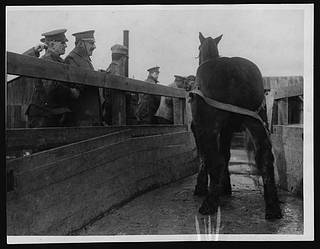
Similar
General Aranaz watching a horse about to enter the bath
Summary
Spanish officers watch a horse being bathed, France. The photograph is taken from the end of a 'corridor' made from ranch fencing. At the end of the corridor there appears to be a bath. There is a horse being lead along it by a soldier who is standing on the other side of the fence. The horse is wearing a lot of straps and gear. Spanish soldiers are standing along the fence watching the proceedings. In the background large wooden sheds are visible. Entertainment of other countries officers helped build good relations between the different countries involved in the Allied Forces...[Original reads: 'OFFICIAL PHOTOGRAPH TAKEN ON THE FRONT IN FRANCE. SPANISH GENERALS VISIT. General Aranaz watching a horse about to enter the bath. This creature refused to go and had to be forced.']..digital.nls.uk/74546638 ( http://digital.nls.uk/74546638 )
World War I (WWI or WW1), also known as the First World War, or the Great War, was a global war centred in Europe that began on 28 July 1914 and lasted until 11 November 1918. World War I Images From National Library of Schotland. These photographs form part of the papers of Field Marshal (Earl) Haig (1861-1928), held by the National Library of Scotland. More information is available from the Library's Digital Archive. Like many World War I generals, Haig remains a controversial figure. The collection contains diaries, papers and photographs from every part of Haig’s career, the Great War diaries being of special importance to historians. Photographs in the "Official Photographs" series (which were destined for publication and have captions on the back describing the image) are in black-and-white. World War I saw the development of a system of 'official’ reporting by professionals especially recruited into the forces. Initially reluctant to allow cameras near the fighting, it took some time for the authorities to appreciate the propaganda and recording potential of photography. These photographs provide us with an invaluable record of how the Government and Military wanted the war perceived. Official photographers were encouraged to record morale-boosting scenes of victory and comradeship. Despite the restrictions placed on them, official war photographers succeeded in giving the most comprehensive visual account of the war. It is important to remember that these images were propaganda; few that could depict the war in a disheartening or disconcerting way passed the censors. As a result the photograph taken was often posed. They were intended to reassure those at home and boost morale. They were printed in newspapers, and were intended to confirm that 'Tommy' was winning the war.
Tags
Date
Source
Copyright info

















































